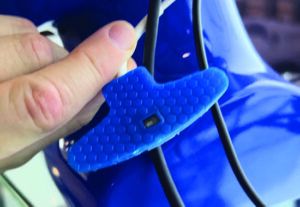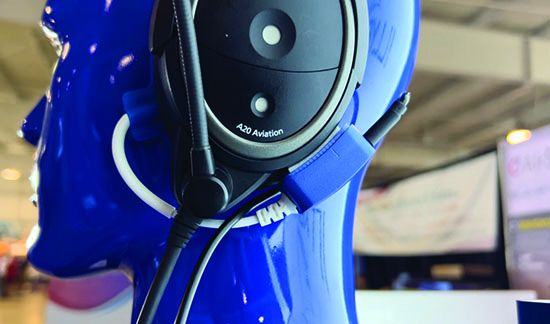The Illyrian full-time wearable SpO2 sensor was one of Aithre Aviation’s first products, and it has been an important component in Aithre’s app (and panel display) cockpit biometric monitoring suite.
Unlike finger pulse oximeters that require an alert pilot to use, the Illyrian’s continuously wearable earlobe pulse ox sensor fits under a headset ear cup (it can also be worn on the forehead with a sport headband) and keeps tabs on SpO2 levels without any pilot intervention. The device automatically transmits a range of health data via Bluetooth to the Aithre Connect smartphone app and Aithre’s Healthview avionics system, if installed.

The latest Illyrian II improves on what we thought was already a smart design (if not somewhat awkward to wear) with some new features. Aithre was showing the preproduction Illyrian II at AirVenture 2023 and we took a close look at it with Aithre’s Dr. James Runnels.
HAPTIC WEARABLE
The wearable honeycomb-surfaced sensor is an improved (gentler on the skin) silicone pad that’s more than a pulse oximeter. Held in place by the headset’s ear cup, it also measures heart rate and body temperature, plus it has a built-in pressure altimeter.
The electronic processor is small enough to attach to the bottom (or the side) of the typical aviation headset’s ear cup, or even on the headband. The new headset-mounted design means the cable that runs from the processor to the sensor pad is short (a couple of inches) and easier to manage than the first-gen Illyrian. One of the nits we had with that first-gen Illyrian was dealing with the USB cable that’s required to power the device. The Illyrian II still requires power input (drawing 10 mA of current) and the micro- USB connector is on the side of the device. Aithre was experimenting with some miniature self-contained USB power supplies that might eventually eliminate having to run a USB power cable from an external power bank or panel power port to the unit.
The Illyrian II has a built-in three-axis gyroscopic sensor that detects if the wearer’s head slouches or doesn’t move for a period of time. A major capability of the device is a new haptic vibrator for alerting the wearer of these hypoxic symptoms. The alerting signatures can be custom configured in the Connect app. Dr. Runnels pointed out that since the device is mounted to the headset, the wearer will easily recognize the vibey alerts because of the high levels of touch receptors that are around the human ear.
These haptic vibrating alert patterns (you’ve felt haptic vibrations on your smartphone and smartwatch) are simple and are designed to not interfere with the headphone audio. As examples, if your head doesn’t move for a period of time, you’ll feel continuous pulses. Hypoxic indicators (or other issues like cabin pressure) might trigger three short pulses. These have configurable thresholds and can be easily turned on or off, or set to monitor specific conditions.
Aithre expects to deliver the new $195 device by the end of 2023. Visit www.aithreaviation.com.

See a video on the Illyrian II at https://tinyurl.com/2p8bvrzt


